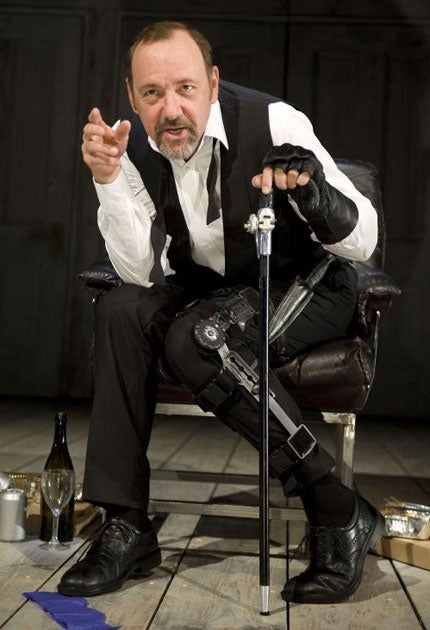First Night: Richard III, Old Vic, London
Mendes, Spacey and a flick of Söze – this is not the usual 'Richard III'

The last time Kevin Spacey and Sam Mendes collaborated – on the film American Beauty – they both came away clutching Oscars. In the interim, they have been professionally associated chiefly through the Bridge Project: the transatlantic ensemble of British and American actors whose home in England is Spacey's own theatre the Old Vic.
But it's now 12 years since the pair joined forces as actor and director. Mendes's new, eclectically modern dress production of Richard III (which is the swansong of the Bridge Project) demonstrates that it has been worth the wait.
There have, it's true, been more creepily charismatic and more unnerving portrayals of Shakespeare's Machiavellian villain. But Spacey's performance combines instinctive, stage-commanding authority with lovely, droll touches of drop-dead understatement.
There are times when this Richard seems like a satanic second cousin of Vincent Price, with his little mocking tosses of the eyebrows, flouncily dismissive flaps of the hand, archly subversive pauses in the middle of a list or a line and in the rather camp complicity he sets up with his dupes onstage and with the audience in the theatre. Equipped with a brutally disfiguring hump and hobbled by a Keyser Söze-style limp, Spacey also communicates a terrible sense of the furious self-hatred, seething resentment and maternally fomented misogyny that evidently drive his Richard. Developing ideas he originated in a staging with Simon Russell Beale in 1992, Mendes's production is a model of clarity, fluidity and pace.
It's incisively shaped to underscore how Richard's control and confidence desert him the moment he ascends the throne. The walls, eerily consisting entirely of doors that have boosted the treacherous atmosphere on Tom Piper's stark box-set, are reconfigured to form a long, tapering coronation room. As the courtiers drum their acclamation so violently that it could be confused for veiled hostility, the ermine-weighted Spacey has to limp the final straight, so to speak, to his heart's desire. Halfway there, he takes a hideously undignified tumble and, enraged, refuses help. Mendes positions the interval just after the cheesy tableau as this Richard crowns himself.
The second half begins with a sardonic action replay of that, only this time instead of seeing it in the distance, we watch it up close as though our seats have been shunted nearer. This is neatly emblematic of the shift of perspective in the play itself as it trains a magnifying glass on Richard in downhill mode. Spacey and the cast bring the play to trenchant life on both sides of the divide.
This Richard's outrageously successful wooing of Lady Anne (Annabel Scholey) is a mesmerising study of how to capitalise perversely on adversity (when she spits in his face, he sees it as a chance to get intimate back and pins her against a door) and it's evidently a psychological turning point in forging his confidence, as we gather from Spacey's incredulous, triumphant cackles and hair-smoothing skit of a simpering dandy. Contrast this with the frantic hollow bluster and empty finger-pointing with which he is forced to parry the caustic rejoinders of Haydn Gwynne's superbly serrated Queen Elizabeth in the equivalent scene in the second half.
Richard's stage-managed fake-reluctance to accept the crown is reimagined here, with Richard talking to the rabble-rousing Buckingham (Chuk Iwuji) and the people from a big screen, as though he has been surprised at prayer by an intrusive camera. A break in the technical link almost blows the gaff on his pose as the picture of troubled, unassuming piety. In addition to giving a modern spin to the black comedy of the political chicanery, Mendes deftly highlights the play's retributive structure. As each of her prophecies comes true and another victim bites the dust, Gemma Jones's brilliantly baleful bag-lady of a Queen Margaret steals in and chalks an "X" on one of the doors.
Spine-tingling, and a most compelling way for the Bridge Project to bow out.
Join our commenting forum
Join thought-provoking conversations, follow other Independent readers and see their replies
Comments